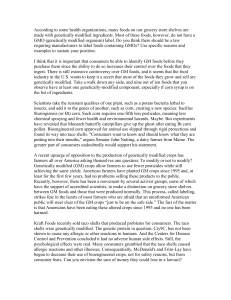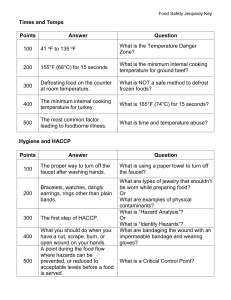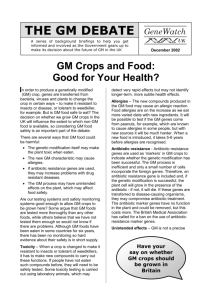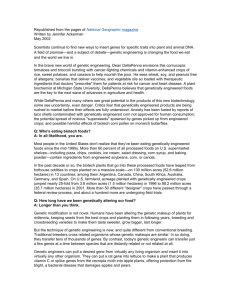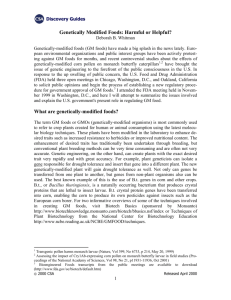Food Fight! - Oconto Falls School District
advertisement
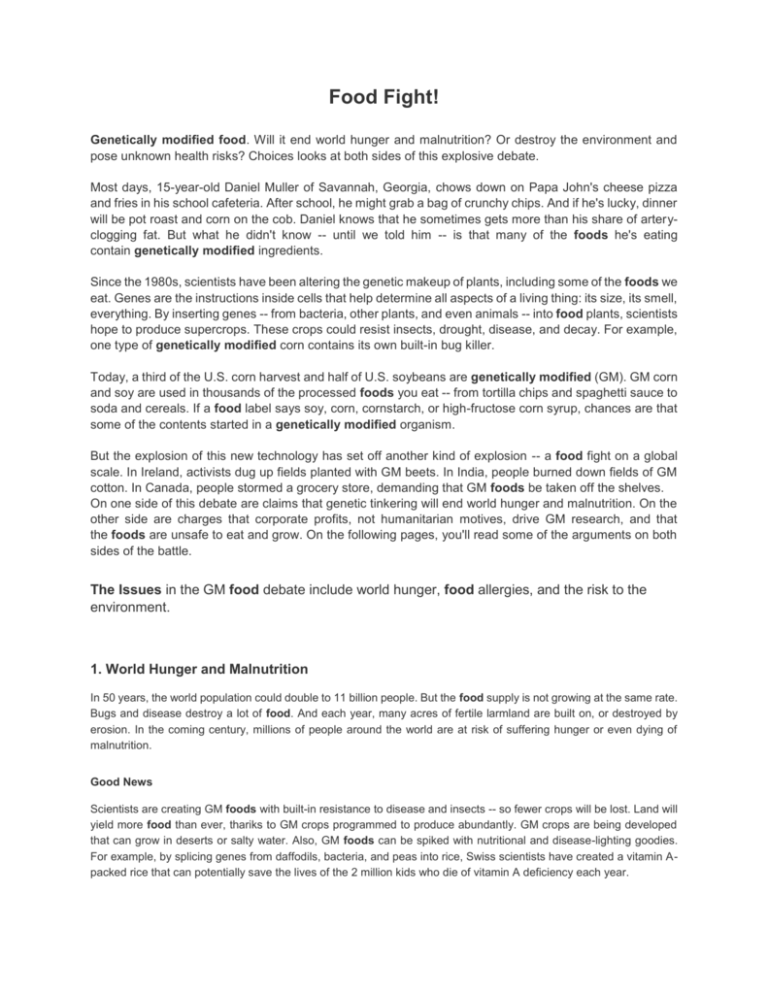
Food Fight! Genetically modified food. Will it end world hunger and malnutrition? Or destroy the environment and pose unknown health risks? Choices looks at both sides of this explosive debate. Most days, 15-year-old Daniel Muller of Savannah, Georgia, chows down on Papa John's cheese pizza and fries in his school cafeteria. After school, he might grab a bag of crunchy chips. And if he's lucky, dinner will be pot roast and corn on the cob. Daniel knows that he sometimes gets more than his share of arteryclogging fat. But what he didn't know -- until we told him -- is that many of the foods he's eating contain genetically modified ingredients. Since the 1980s, scientists have been altering the genetic makeup of plants, including some of the foods we eat. Genes are the instructions inside cells that help determine all aspects of a living thing: its size, its smell, everything. By inserting genes -- from bacteria, other plants, and even animals -- into food plants, scientists hope to produce supercrops. These crops could resist insects, drought, disease, and decay. For example, one type of genetically modified corn contains its own built-in bug killer. Today, a third of the U.S. corn harvest and half of U.S. soybeans are genetically modified (GM). GM corn and soy are used in thousands of the processed foods you eat -- from tortilla chips and spaghetti sauce to soda and cereals. If a food label says soy, corn, cornstarch, or high-fructose corn syrup, chances are that some of the contents started in a genetically modified organism. But the explosion of this new technology has set off another kind of explosion -- a food fight on a global scale. In Ireland, activists dug up fields planted with GM beets. In India, people burned down fields of GM cotton. In Canada, people stormed a grocery store, demanding that GM foods be taken off the shelves. On one side of this debate are claims that genetic tinkering will end world hunger and malnutrition. On the other side are charges that corporate profits, not humanitarian motives, drive GM research, and that the foods are unsafe to eat and grow. On the following pages, you'll read some of the arguments on both sides of the battle. The Issues in the GM food debate include world hunger, food allergies, and the risk to the environment. 1. World Hunger and Malnutrition In 50 years, the world population could double to 11 billion people. But the food supply is not growing at the same rate. Bugs and disease destroy a lot of food. And each year, many acres of fertile larmland are built on, or destroyed by erosion. In the coming century, millions of people around the world are at risk of suffering hunger or even dying of malnutrition. Good News Scientists are creating GM foods with built-in resistance to disease and insects -- so fewer crops will be lost. Land will yield more food than ever, thariks to GM crops programmed to produce abundantly. GM crops are being developed that can grow in deserts or salty water. Also, GM foods can be spiked with nutritional and disease-lighting goodies. For example, by splicing genes from daffodils, bacteria, and peas into rice, Swiss scientists have created a vitamin Apacked rice that can potentially save the lives of the 2 million kids who die of vitamin A deficiency each year. Bad News There's a lot that scientists still don't know about the role of nutrients in disease prevention. We know that vitamin A and other nutrients in foods are vital to good health. But there are probably other crucial compounds in foods that haven't been discovered yet. Genetic engineers could accidentally decrease levels of those substances. 2. Food Allergies Common foods, such as nuts, fish, and milk, cause seary and even fatal allergic reactions in some people. If genetic engineers blend ingredients from these allergy-causing foods into other foods, allergic people may not be able to avoid the foods that make them sick. Bad News The risk of allergies is small, but real, says Rebecca Goldburg, a scientist with Environmental Defense, a New York activist group. For example, when foodengineers added a Brazil-nut gene to soybeans, people who were allergic to nuts became sensitive to the beans. Goldburg worries that dangerous genes could slip through as more foods are engineered. Also, new food allergies could be created as scientists introduce new genes into the food supply. It can take up to 10 years for people to develop allergies to new substances. Good News Steve Taylor, the University of Nebraska scientist who detected the danger in the soybeans, says the food-allergy threat is small because food engineers now avoid using genes from nuts and other common food allergens. The benefits of genetic engineering justify the risk, says Taylor. Also, genetic engineers will eventually save lives by identifying and removing the ingredients in foods that cause dangerous allergic reactions. For example, the future may yield a hypoallergenic peanut! 3. The Environment Living things coexist in a delicate balance. Uistory has taught us that any change -- even small -- can spell disaster. For example, when mongooses were introduced in Hawaii to kill rats, they almost wiped out the island's bird population. No one knows how the new GM plants will affect the environment. Good News The chemical pesticides used on crops pollute the air and water and can poison wildlife and humans. The GM crops growing on farmland across the country include corn with builtin bug killers and soybeans that can survive treatment with powerful weed killers. These crops can be grown with less chemical insecticides and safer weed killers. Bad News Bug killers built into crops may harm beneficial bugs, including endangered insects such as the monarch butterfly. In a prcliminary study, a Cornell University researcher found that butterfly larvae that ate GM corn pollen were more likely to die sooner than those that are the pollen of regular corn. Some ecologists also fear that these crops will breed with regular plants, dispersing the built-in bug killer and other powerful traits into the wild. And once they are out in the wild, there will be no way to stop them from spreading. For example, a new type of "superweed" that pesticides can't kill may choke farms and destroy wildlife. ~~~~~~~~ By Peter Fairley and Pearl Gaskins Copyright of Scholastic Choices is the property of Scholastic Inc. and its content may not be copied or emailed to multiple sites or posted to a listserv without the copyright holder's express written permission. However, users may print, download, or email articles for individual use.

